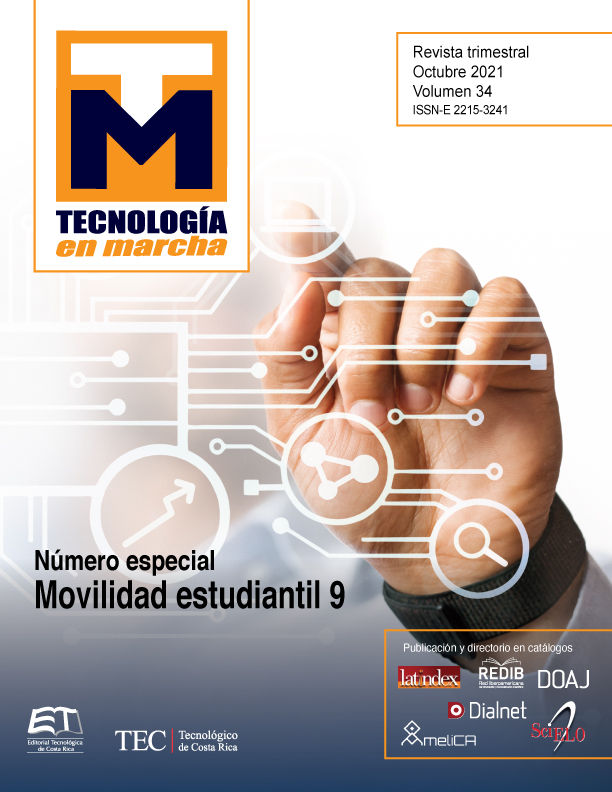Physical and mechanical behavior of non-structural elements elaborated of concrete made with rice husk fiber
Main Article Content
Abstract
In this research work, the physical and mechanical behavior of concrete dosages with natural fibers used for the preparation of non-structural block elements were studied. The dosages were made with a Portland cement binder and as the only aggregate the rice husk without any previous treatment, in this project, this mixture is called bio-concrete. This project was carried out at the National School of Public Works (ENTPE) of the University of Lyon in research alliance with the School of Engineering in Construction of The Tecnológico of Costa Rica. Different formulations of bio-concrete were studied where mechanical behavior like compression in cylindrical specimens was analyzed in order to choose two formulations, one for Costa Rica and one for France. Once the formulations were chosen, it proceeded to study the mechanical compression behavior in cylinders, the flexion in prisms, the thermal behavior in specimens of both formulations, culminating with the mechanical behavior of compression and flexion of blocks of 15x20x40 cm (width, height and large). The results show compliance with the minimum resistance to compression of the regulations in force for Costa Rica and France, both formulations also allow to have a material with high thermal insulation capacity and densities less than 1 500 kg/m3. Therefore, the material is not limited to be used in walls, but could be also used in ceilings, floors and finishes.
Article Details

This work is licensed under a Creative Commons Attribution-NonCommercial-NoDerivatives 4.0 International License.
Los autores conservan los derechos de autor y ceden a la revista el derecho de la primera publicación y pueda editarlo, reproducirlo, distribuirlo, exhibirlo y comunicarlo en el país y en el extranjero mediante medios impresos y electrónicos. Asimismo, asumen el compromiso sobre cualquier litigio o reclamación relacionada con derechos de propiedad intelectual, exonerando de responsabilidad a la Editorial Tecnológica de Costa Rica. Además, se establece que los autores pueden realizar otros acuerdos contractuales independientes y adicionales para la distribución no exclusiva de la versión del artículo publicado en esta revista (p. ej., incluirlo en un repositorio institucional o publicarlo en un libro) siempre que indiquen claramente que el trabajo se publicó por primera vez en esta revista.
References
Lehne, J., & Preston, F. (Junio de 2018). Chatham House Report. Obtenido de Making Concrete Change Innovation in Low-carbon Cement and Concrete: https://www.chathamhouse.org/sites/default/files/ publications/2018-06-13-making-concrete-change-cement-lehne-preston-final.pdf
Global Cement and Concrete Association. (2019). Global context and quick definitions about concrete. London, United Kingdom.
Federación Internacional del Cemento. (2018). Cifras de la industria cementera. Obtenido de Informe Estadístico 2018: http://ficem.org/dev/wp-content/uploads/2018/09/CIFRAS-DE-LA-INDUSTRIA-CEMENTERAMUNDIAL.pdf
Herrera Mejía, J., Osorio Saraz, J., & Varón Aristizabal, F. (28 de Febrero de 2007). Comportamiento Mecánico del Concreto Reforzado con Fibras de Bagazo de Caña de Azúcar. Medellín, Colombia: Revista DYNA, Universidad Nacional de Colombia.
Nguyen, T. (2010). Contribution à l’étude de la formulation et du procédé de fabrication d’éléments de construction en béton de chanvre. Génie civil. France: Université de Bretagne Sud.
Molina Salas, E. (Enero de 2010). Evaluación del uso de la cascarilla de arroz en la fabricación de bloques de concreto. Cartago, Costa Rica: Tecnológico de Costa Rica.
Mena Rodríguez, L. I. (2019). Análisis de las propiedades físicas de concretos modificados con fibras vegetales: cáscara de arroz. Cartago, Costa Rica: Tecnológico de Costa Rica - ENTPE.
Serrano, T., Borrachero, V., Monzó, J., & Paya, J. (2012). Morteros aligerados con cascarilla de arroz: Diseño de mezclas y evaluación de propiedades. DIALNET, 79, 128-136.

